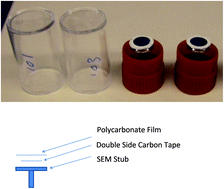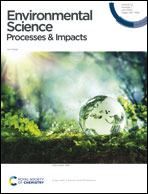Using low cost open-face passive samplers to sample PM concentration and elemental composition in childcare facilities†
Abstract
Effective, low noise and low-cost samplers for airborne particulate matter (PM) in indoor environments are needed. In 15 northern California childcare facilities, we deployed open-faced polycarbonate substrate passive aerosol samplers and analyzed them using computer-controlled scanning electron microscopy to measure indoor PM particle size, number, and elemental concentration. Particle concentrations were compared to PM concentrations measured by filter-based active samplers. The PM mass concentrations measured after open-faced passive sampling were in good agreement with the PM concentrations obtained using co-located active samplers. The measured PM2.5 concentrations inside of the childcare facilities were in the range of 6–31 μg m−3, while the PM10 concentrations were in the range of 17–96 μg m−3. For PM10, 93.3% of the passive sampler results were within ±30% of those determined with the active sampler, and 67% of the PM2.5 results fell within ±30% of the active sampler measurements. The Pearson's correlation coefficient between PM mass concentrations estimated from the open-faced passive aerosol sampler (OPS) versus gravimetric (active sampler) methods was 0.77 for PM2.5 and 0.95 for PM10, respectively, indicating a strong correlation between the passive and active sampler results. PM and elemental composition varied by facility location and interior characteristics of the childcare facilities such as floor type, presence of combustion sources, occupant density, and the level of activity. The rich carbon content in the polycarbonate substrate produced positive bias in the carbon concentration analysis. Based on the carbon concentration, determined using a copper substrate, a correction factor was needed to determine the total carbon concentrations in the sampled PM for the polycarbonate substrate passive sampler. Overall, the results demonstrated that the OPS collected enough aerosol particles in one business day (6–8 hours) to assess PM levels.



 Please wait while we load your content...
Please wait while we load your content...